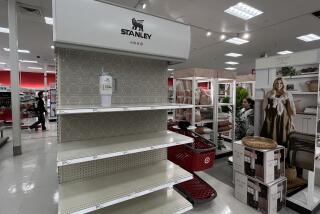Will Blitz of Millennial Goods Spell Boom or Bust for Retailers?
- Share via
New Year’s usually doesn’t capture the attention of shoppers until the week after Christmas, and even then its retail punch is confined mostly to party goods, beverages and food.
But to say this year is different would be an understatement. Fueled by media and marketing hype, conventional wisdom has anointed this coming Jan. 1 as not merely the start of a new year, but the beginning of a new millennium even though that date is still more than 14 months off, given the precepts of the modern calendar.
No matter. With its odometer-rollover sexiness, the birth of 2000 has spawned a blitz of consumer goods--commemorative calendars, scrapbooks, board games, even beer. They began hitting shelves as early as last year as manufacturers and retailers jockeyed to cash in on the event’s once-every-thousand-year cachet.
But unlike Christmas and other annual rituals, retailers and manufacturers have no experience with a millennium. There’s no guidebook of do’s and don’ts on how to market it--or even any certainty that it won’t be a big bust.
“Actually, because we’ve never been through a millennium we don’t know exactly when things are going to sell,” said Rachel Bolton, spokeswoman for Kansas City, Mo.-based Hallmark Cards, whose millennial product line includes greeting cards, toys, T-shirts and baseball caps.
That uncertainty has given rise to an elongated marketing season that stretches back as far as December 1997, when M&M; candy maker Mars Inc. proclaimed its plain and peanut chocolates “the official candy of the new millennium.”
Retail industry observers caution that too much millennial buzz could backfire. They warn that hype-weary consumers might turn their back on 2000-themed products at a time when that market should be hitting peak demand, sticking retailers with leftover inventory for an event that will likely have little or no sales life after Jan. 1.
“I’m glad I’m not a retailer, let’s just put it that way,” said Sally Schaadt, a consumer and retail analyst for the Fourteen Research Corp. in New York. “Retailers really have to be careful in terms of inventory because once it’s over, it’s over.”
USC marketing professor David Stewart agrees: “I think there’s a really good chance retailers could wake up the next morning with a lot of unsold inventory.”
It’s a scenario that, not surprisingly, most shopkeepers wish to avoid.
Cathleen Baclaski, manager for the Museum Company gift shop at the Glendale Galleria, said buyers for the chain, which includes nine outlets in Southern California, are generally pretty accurate in their sales forecasts when they purchase inventory. But the stock of roughly 100 millennium-themed products the chain’s stores now carry could upset that record. “It’s a test,” Baclaski said.
The Museum Company has much at stake. In June the chain’s stores began repackaging themselves as a headquarters for millennial goods, stringing banners that herald their wares “The Millennium and the Treasures of Time.”
The banners are broken into color-coded squares depicting each of the past 10 centuries. Colored stickers matching the squares appear on items throughout the store, letting customers know the era each piece corresponds to.
“We’re a store about history,” Baclaski said, explaining the store’s embrace of millennium marketing.
But some customers, like Tomoko Watanabe, a 32-year-old illustrator from Pasadena, weren’t convinced. “I don’t know, [the year 2000] is just a number. It’s a reason for people to party,” she said after perusing the store’s collection of calendars. “I think it’s just something for them to use to sell things.”
Not all consumers apparently share her view. Baclaski said that sales have been brisk for millennium-edition playing cards and board games, time capsules, scrapbooks and, most of all, calendars.
“People started asking us in April for calendars with the year 2000. That’s never happened before,” she said. “They’re just buying them to collect them. They’re buying six or seven calendars as something to hold on to. They could be worth something someday.”
Such enthusiasm has been a boon for calendar makers. Avalanche Publishing in Huntington Beach, for example, reported year-to-date calendar sales have jumped by 40%. At the same time, publisher Lang Cos. in Delafield, Wis., also posted double-digit growth in sales, and president Robert Lang has already prepared for a late-season press run to make additional calendars if need be.
“I think there’s going to be a tremendous late surge in consumer awareness and consumer demand,” he said. “I think the market is going to be caught off guard.”
Calendars make sense as a keepsake, but does a coffee mug? That’s the question Budd Goldman, product developer and president of Mineola, N.Y.-based Countdown Clocks International Inc., asked himself when he began strategizing over millennium products in 1996.
Concerned that millennium marketing excess could ultimately damp demand, Goldman dismissed what he considered “routine novelties” such as T-shirts and caps and opted for something he thought would appeal to consumers early. The result was a digital clock that, instead of normal timekeeping, ticks down the seconds remaining until Jan. 1.
Since the introduction of the Millennium Countdown 2000 Clock in May 1998, roughly 1.5 million have been sold, Goldman said, but only about 30% of those sales have come since January. Goldman is not surprised. Not only does the value of the countdown clock decrease the more time it ticks away, he said, but the overall din of millennium hype has taken its toll not just on sales of his clock but on everything of its ilk.
“The millennium has become a nonevent,” he said. “It’s a bust. There’s nothing but apathy out there.”
Teresa Vega, manager for Party World party supply store in Burbank, hopes that’s not the case.
Her store has purchased more New Year’s Eve supplies--horns, hats, streamers--than it has in years past and has begun displaying them in the front of the store, two months earlier than normal. Worries about leftover inventory, she said, prompted the decision.
“That’s why we decided to put it out this far in advance,” Vega said. “It’s very early for us, but we’re trying to have product in place.”
Marketing professor Stewart advises retailers like Vega to be cautious with future wholesale purchases “so that they don’t go into the last few weeks [of the year] with a lot of inventory on hand.”
Such a predicament, he said, could leave many retailers with no choice but to slash prices in the waning days of the year in an effort to move millennial goods out of their stores. “I wouldn’t be surprised if we had a lot of fire sales at the last minute,” he said.
Still, Stewart feels retailers almost have no choice but to gamble on the allure of the year 2000 and its weighty cultural significance: “It’s just too good a marketing opportunity to pass up.”
More to Read
Inside the business of entertainment
The Wide Shot brings you news, analysis and insights on everything from streaming wars to production — and what it all means for the future.
You may occasionally receive promotional content from the Los Angeles Times.










